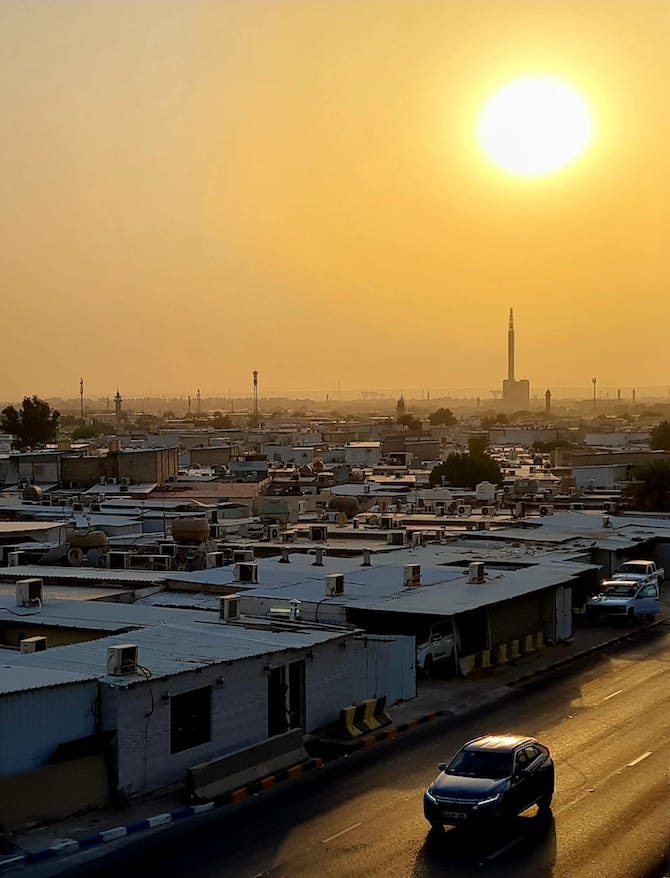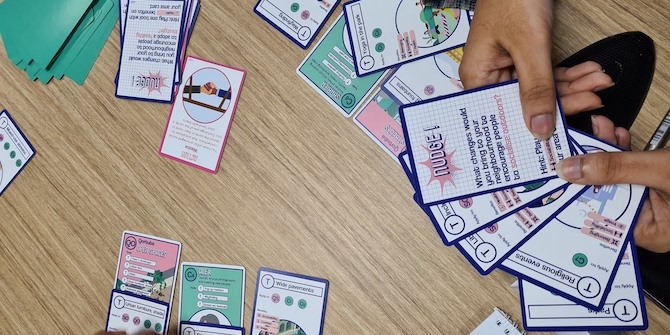by Spyros A. Sofos and Nazanin Shahrokni

The development of Kuwait City’s urban agglomeration – home to 3 million inhabitants – 71.2 percent of the country’s population – has been impacted by the discovery of oil in 1938. The move towards a hydrocarbon-extraction and export economy prompted the rewriting of Kuwait’s social contract. As citizenship became the key to benefiting from Kuwait’s wealth, a complex system of differential inclusion and exclusion was devised to identify those entitled and the type and extent of entitlement. Tiered citizenship, gender inequalities, class differentials, a large stateless population (Bidūn) and the precarity of low-skilled expatriate workers are features of Kuwait’s socio-political, and, we argue in our Ecologies of Belonging and Exclusion in Kuwait City project, urban ecology. Urban Kuwait is the outcome of a drive to push aside the old and redesign the city from above without limitations posed by antecedent urban geographies. Here we provide an outline of key findings on how the city is envisioned and designed from above, and how city-dwellers revision and rewrite it.
Segregation by Design
The discovery of oil enabled Kuwait’s rulers to turn Kuwait’s citadel into a modern administrative and commercial centre. It also provided the opportunity to graft on the canvas of urban space the hierarchical character and divides of Kuwait. The citadel, almost in its entirety razed to the ground, formed the administrative and financial core of the modern metropolis. Concentric peripheral roads demarcated the al-manãtiq al-numüdhajiyya (model ‘inner’ suburbs housing the city-dwelling ḥaḍar), the al-manãtiq al-khãrijiyya (outlying suburbs where nomadic origin badū were settled), and the under-resourced and less connected to the rest of the city, sha’biyya (popular housing) districts, home to many Bidūn, and the neighbourhoods where most migrant workers live in congested and unsanitary spaces. Although city-dwellers circumvent this divide by mingling in spaces such as the seafront, or as Kuwaitis sublet apartments in their neighbourhoods to higher-income expatriates, the city’s fragmentation endures. Among the privileged, prejudice, the discomfort of proximity to ‘others’, and among those lower in the social hierarchy, solidarity networks and the lack of choice contribute to city-dwellers gravitating toward ‘people like them’, maintaining the city’s fragmentation. Apart from the residential topography, our interviewees stress that segregation is also reflected in the city’s service provision geography: schools remain segregated, and major roads become boundaries restricting access to services and amenities to those unlucky enough to find themselves on the wrong side of the road.
Apart from the differentials reproduced by one’s place, one can discern disparities in the ability to move in the city. The emphasis on car ownership affects the mobility of migrant workers who, facing administrative restrictions preventing them from obtaining driving permits, rely on a public transport system not fit for purpose. Despite initiatives promoting public transport, interviewees, stressed the unreliability of bus services and the disproportionate time required to cover relatively short distances. Indeed, bus routes meander through the city stopping frequently in front of businesses employing their passengers, rendering a 15-minute-long drive into a one hour-long bus ride, adding time poverty to other disadvantages passengers face. The embeddedness of ‘car culture’ in Kuwaitis’ daily life means that their residential areas are not serviced by the bus network developed with non-Kuwaiti workers in mind. Thus, female domestic workers living with their employers ´ration´ their mobility as moving in the city is dependent on expensive taxi rides and potential exposure to harassment by male taxi drivers. The fear of harassment is not restricted to female foreign workers alone: most female informants note the gendered character of most public spaces which inhibits their mobility, especially in cases when they might find themselves alone among unknown men.
Kuwait’s urban masterplans envisioned the suburbs housing Kuwaitis to be self-sufficient, with local open spaces, schools, mosques, and cooperative markets. Plans excluded the infrastructure-starved high-density areas housing non-Kuwaitis, or the tucked-away Bidūn neighbourhoods comprising “temporary” inadequate and overcrowded low-cost housing often lacking key amenities. Motorisation favoured ‘roads’ traversing the city, rather than walkable ‘streets’ connecting neighbours and communities. Lack of pavements for able-bodied residents, let alone for people with disabilities, or residential areas separated by motorways with no pedestrian crossings discourage walking. Even for those determined to walk, the streets might prove dead-ends as green areas often get built up by unscrupulous developers or residents or become car parks, while local parks can be neglected, overshadowed by status-related flagship developments away from most residential areas. Many pointed out the remoteness of Al Shaheed Park – Kuwait’s largest green infrastructure project – to most parts of the city which have seen their green spaces neglected. Part of a series of developments – soaring corporate towers and massive mall complexes such as The Avenues in the Al-Rai District – the park is a highly regulated space. A ban on food and beverages not purchased in the park’s restaurants, the prohibition of picnics, bicycles, and skateboards and the lack of play spaces for children exclude young families and people who cannot afford to use its commercial facilities. The park, and other similar open spaces in the city centre have been intended to emulate the (western) public space ideal without consideration of Kuwait’s climate, urban geography, and culture, and adding restrictions and prohibitions that render them alienating.

Segregation in the city manifests itself in a variety of ways: People live apart, traverse it apart, work apart and converge to enjoy it apart to the extent that we can talk about different groups populating different urban geographies. There is a dearth of spaces where city-dwellers can overcome divides, especially those of citizenship status and class, encounter, ‘recognise’ and learn from each other.
Rewriting the city from below
Whereas Kuwaitis and affluent expatriates may feel at home at exclusive shopping malls, corporate plazas or Al Shaheed Park, where diversity is carefully circumscribed, monitored and coupled with conspicuous consumption, others resort to rewriting the city, making it also theirs.
Early on, families or neighbours countered the atomising effect of relocation to the suburbs and maintained neighbourhood solidarity (firjãn) by bidding for adjacent suburban houses. Others shared stories of residents repairing their small neighbourhood park playground so that local children could enjoy it. Away from the neighbourhoods, in the absence of relatable public spaces, people turn to less exclusive malls, subverting their functions, adapting them to local socio-cultural needs. Malls – the equivalent of commercialised open spaces – provide opportunities for social interaction, from people-watching to occasional encounters across class and status boundaries. They become sites of fleeting contacts with the opposite sex in the absence of alternatives, while for younger interviewees, less popular malls are places free of the scrutiny of the family that offer moments of liberation and invisibility.
Migrant workers imbue places with meaning, such as Salmiya’s Little Manila area with its Filipino ambience, teaming with small worn-out stalls, restaurants and shops, where visitors can hang out or buy products they need or miss at cheaper prices, as children cycle and run about. During their days-off they congregate in mall car parks, or at the ‘Duwwar El-Sheriton’, a large, landscaped roundabout, 3km from Al Shaheed Park, near a bus hub, churches, mosques and small shops. It is the rewriting from below of such disused or not intentionally designed places that host this coming-together of Kuwait’s ultimate ‘outsiders’ of different backgrounds that momentarily subverts the city’s exclusionary nature.
Environmental interventions seem to be more successful in bringing together a cross-section of the city: The appeal of the Secret Garden at Salmiya’s Baghdad Street, an effort to reshape a disused space and grow plants and vegetables, or of the lush garden at Shamiya’s Nature Reserve Youth Centre, a rare example of collaboration of volunteers from diverse backgrounds and the authorities indicate that the environment is a convergence point where ‘environmental’ and ‘cultural sustainability’ – the capacity to create and nurture together – is achieved.
Such micro-strategies of reclaiming the city, regaining autonomy and the ability to shape the city may not radically alter urban space but testify to growing voices for alternative ways of being and moving in it, reinvigorating neighbourhoods, reintroducing human scale in everyday life and creating open spaces, conducive to more spontaneous human interaction. They may be fragmented, but they provide valuable insights for those planning the city from above about how to rethink urban Kuwait.
This blogpost draws on field visits, observation and 40 interviews with activists and academic experts for the Ecologies of Belonging and Exclusion: An Intersectional Analysis of Urban Citizenship in Kuwait City project. The authors would like to thank Layan al Dabt and Muneera AlYahya for their research assistance and Nour Almazidi for her invaluable support.






